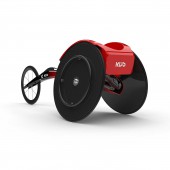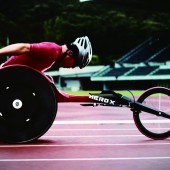WF01TR Racing Wheelchair by RDS Co., Ltd. |
Home > Winners > #102191 |
 |
|
||||
| DESIGN DETAILS | |||||
| DESIGN NAME: WF01TR PRIMARY FUNCTION: Racing Wheelchair INSPIRATION: This project began from the development of a racing wheelchair for the Paralympic Games. As the development progresses, the design team began to understand the importance of having an athlete fit perfectly in the right place. In case of prototype for test, the seating position affected the record. And the obvious data has made us easier to understand experienced athletes and communicate with each other much more about wheelchair development. UNIQUE PROPERTIES / PROJECT DESCRIPTION: A racing wheelchair developed and designed to maximize the athlete's own abilities and improve competitive performance. The design focusing on the short-distance event is ultra-lightweight, high-rigidity and high acceleration, while improving body hold and stability when cornering. The seat position is determined by the seat position simulator SS01, including the optimization of the rowing of the players, and the manufacture is done order made. OPERATION / FLOW / INTERACTION: The operating procedure is the same as that common in competitive wheelchairs. 3D scanned body shapes are applied to the seat to enhance the sense of unity between the wheelchair and the athlete. Stable and high cornering performance without disrupting the athlete's concentration during competition. PROJECT DURATION AND LOCATION: The project started in August 2017 in Japan and finished in September 2019 FITS BEST INTO CATEGORY: Vehicle, Mobility and Transportation Design |
PRODUCTION / REALIZATION TECHNOLOGY: CFRP Monocoque Frame SPECIFICATIONS / TECHNICAL PROPERTIES: Width 650 mm x Depth 2100 mm x Height 700 mm TAGS: Wheelchair, Paralympic, Sports, Athletes, Carbon fiber, RESEARCH ABSTRACT: The development team intended from the outset to apply the findings from the development to other wheelchairs, exploring how to set up an efficient athlete's riding position and the structural design of a high performance wheelchair. In addition to driving tests and development of fabrication techniques based on prototype prototypes, we designed the frame using FEM analysis. CHALLENGE: The challenges in the development of the wheelchair were to flexibly adapt to the seat positions set for each athlete using the simulator, to achieve the rigidity and strength of a high performance wheelchair, and to give it a sleek styling while achieving a high level of productivity. ADDED DATE: 2020-02-28 08:49:59 TEAM MEMBERS (9) : RDS Co., Ltd., Tomoya Ito, fuRo, exiii design Inc., MAGNET Inc., makesense Inc., quod, LLC, honey l days and 1-10,Inc IMAGE CREDITS: RDS Co., Ltd. |
||||
| Visit the following page to learn more: http://www.rds-design.jp/?lang=en | |||||
| AWARD DETAILS | |
 |
Wf01tr Racing Wheelchair by Rds Co., Ltd is Winner in Vehicle, Mobility and Transportation Design Category, 2019 - 2020.· Press Members: Login or Register to request an exclusive interview with RDS Co., Ltd. . · Click here to register inorder to view the profile and other works by RDS Co., Ltd. . |
| SOCIAL |
| + Add to Likes / Favorites | Send to My Email | Comment | Testimonials | View Press-Release | Press Kit |







